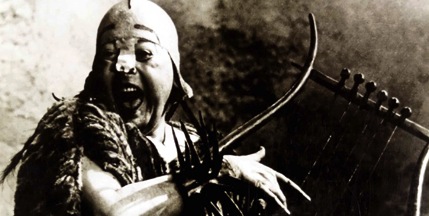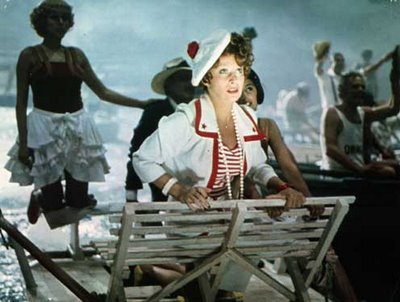At some point in your life, unless you are very young or have lived under a rock, you have probably heard someone say something like this: “I swear! They looked like they had just stepped out of a Fellini movie!”
The characters depicted in Federico Fellini’s films are quite memorable. The most memorable of the Fellini bunch tend to be those characters with the least amount of screen time. Take Eddra Gale as an example. Eddra was cast as La Sarghina in Fellini’s 8 1/2 and the facial exaggerations she makes and movements of her dance on the beach are forever seared into pop culture consciousness.

Eddra Gale as La Saraghina in Fellini’s 8 1/2
Fellini did not cast Eddra Gale for her beauty, grace or talent. He cast her because he found her facial movements fascinating. And, the dance of La Saraghina on the beach is at once erotic, comical, disturbing and oddly beautiful. It is a screen moment that has been admired, copied and haunted millions of viewers.
By the time Federico Fellini’s films moved into the mid-60’s he was losing interest in narrative plot and seemed to be more concerned with the images he captured. One of the challenges facing those new to Fellini in the 21st Century is that nearly all of his films are dubbed. And, they are dubbed badly. Most of these films were made during the time when there was a great curiosity around the idea of International Cinema. European directors were scrambling to cast a Hollywood actor in one of their films. Very often, in fact most often, the American actors did not speak the language used for the movie in which they had been cast. Art House audiences were used to dubbing. However, Fellini appears to have reached a point when the actual sounds of voices and actions no loner mattered to him at all. Fellini was about the images.

Federico Fellini
Many cite that Fellini spoke of an LSD trip he took that forever changed his view of life that changed his films from the “unusual” to the downright “bizarre” but I feel that concept could easily be debated. Fellini grew as an artist. He was literally a clown who found himself a filmmaker. And, he just happened to turn out to be one of the major geniuses of cinema. He was far from Surreal. While his shots might be off-center and strange, his films are very much grounded in both reality and humanity. Fellini created some of the most striking portraits of humanity we are likely to see. And, he made them at a time when realism in movies was very much in its infancy.

Fellini filming. Photograph by Mary Ellen Mark
Even when Fellini took a wrong turn such as with his adaptation of the life of Casanova, the movie stands up for the simple reason that there are so many interesting characters to simply watch. Donald Sutherland was badly cast and even appears confused as he wanders through the sets of Fellini’s Casanova, but you are never bored because there is always an actor who captures your attention. Or, even a character who appears to be looking at you.

Donald Sutherland and A True Character in Fellini’s Casanova, 1976
Fellini’s films are filled with extras. His camera spends a great deal of time showing the audience these other characters. Even as the main character’s mouth moves and some disembodied voice speaks, you often find yourself looking to the left or right or even behind to see the unusual assortment of amusing characters.

Fellini Satyricon, 1969
In 1981 Christian Strich edited and published a book titled Fellini’s Faces. It was published in the US in 1981 by Holt, Rinehart and Winston Owl Books. It is comprised of “Actor Head Shots” which were kept in an “archive” at Fellini’s office in Italy.
From the very beginning of his film career, Fellini was obsessed with finding actors who envisioned those who he felt conveyed what he wanted to convey. By 1967, Fellini was far more concerned with how an actor looked or moved. Most often, this was more important than talent. In an all too brief introduction Fellini wrote for Strich’s book he explains that actors are more like puppets to him than collaborators. He knew what he wanted and the actor was to be manipulated for that purpose.
No matter where Fellini was or what he might be there to do, he was always in casting mode. It reached a point where he would set aside one day a week to simply sit and chat with anyone interested in being in one of his movies. These meetings happened everywhere from Italy to Hollywood to Paris to remote villages in Europe. Fellini enjoyed people and he loved to be around those who were fun or/and interesting.
He would meet with anyone as long as they agreed that he had the right to photograph them. People were encouraged to bring a photo of themselves but he usually always took an additional photograph at the time of the chats. He met people from all walks of life: professional actors, beggars, prostitutes, strippers, drug dealers, bored housewives, business men and anyone who would just want to talk. It was almost without question that his casting decisions for his extras and many larger roles were based on something about the way the person looked, carried themselves or some unique thing that caught his eye or intellect. And, sometimes it might just boil down to the fact that he liked a person’s choice of hat or glasses. The book notes that he sometimes only photographed the hat or the glasses.

Fellini Satyricon, 1969
Quite often he would cast someone simply because he enjoyed his/her company. If he met someone who made him laugh, he might cast that person on this fact alone.
After these meetings, Fellini would have his photographs developed and create a file consisting of the photograph(s), the individual’s contact information and any notes or illustrations he might have made during the meeting. He then gave the files to his assistants who placed them in an organized Face Archive. These archive became quite huge over time. Consisting of over a thousand files, Fellini would consult his archive as ideas, concepts or plots for films came into his mind.
Christian Strich was allowed access to the Fellini Face Archive and chose 400 to put in the book. Please note that Strich cataloged each photograph so that the reader could find the name of the individual. I decided to not list the names of the people. I do wish that Strich had been able to identify dates and whether or not the photograph had been taken by Fellini. Many of the photographs are blurry. These portraits are not about photographic art. They are about the faces and personalities captured.
For me this only further testifies to the humanity of Federico Fellini’s movies. And, the photographs are incredible. Sadly, this book has been out of print for some time.
The following are several of the photographs that really caught my eye. Oh, and if you are familiar with the fun world of Cult Cinema or Bad Movies, you will most likely recognize Chesty Morgan in the first photograph. I suspect that she provided this picture to Fellini as it looks like a promo shot she would have used during her Times Square stripper days.
“…Now my job is to find the faces that will give it (the movie) life!”
Fellini, 1980
And, of course, Federico Fellini did just that until the end of his life in 1993.
Matty Stanfield
July/2012






















